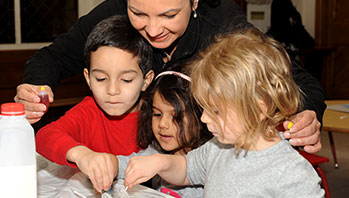- rubber bands of different thicknesses
- shoe boxes, bread pans, and other open containers around which the rubber bands can be stretched
- high
- low
- pluck
- sound
- vibrate
MA Standards:
Language: LS.PK.4 Ask and answer questions about the meaning of new words and phrases introduced through books, activities, and play.
MA Draft STE Standards:
Physical Sciences/Matter and Its Interactions: Structures and Properties of Matter PS1.B Differentiate between the properties of an object and those of the material of which it is made in science explorations and activities such as art and music.
Physical Sciences/Energy PS4.A Investigate different sounds made by different objects and different materials and reason about what is making the sounds. [Cause and Effect]
Head Start Outcomes:
Logic and Reasoning/Reasoning and Problem Solving Recognizes cause and effect relationships.
PreK Learning Guidelines:
English Language Arts/Language 2 Participate actively in discussions, listen to the ideas of others, and ask and answer relevant questions.
Small Group: Rubber Band Guitars

© Commonwealth of Massachusetts, Department of Early Education and Care (Jennifer Waddell photographer). All rights reserved.
STEM Key Concepts: Sound is caused by a vibration; An action has to happen to make a sound; Sounds vary in three ways: volume, pitch, and timbre; A sound becomes louder when the force of the action creating the sound is increased; A sound becomes softer, or quieter, when the force is decreased
ELA Focus Skills: Listening and Speaking, Vocabulary
Join small groups of children to continue exploring the materials at the Science and Math Center. Have children continue to explore plucking the rubber band guitars and observing how the band vibrates, or wiggles quickly, to make a sound.
Have children explore other vibrations. Have children place their hand over their throat and sing “la-la-la.” Ask,
- How does it feel? Why do you think so? Explain to children that when they make sounds with their voice, the vocal chords inside their throats vibrate back and forth.
- Let children practice feeling the vibrations in their throats as they make different kinds of sounds such as buzzing, singing, or talking in high and low voices.
Reflect and Share
Have children share their observations. Invite children to demonstrate how to make a high and low sound with the rubber band and with their voices. Encourage children to use the term vibrate as they share their observations.
English Language Learners: Demonstrate the meaning of vibrate using gestures and body movements (wiggling your finger/body). Repeat the word as you demonstrate. Then pluck the rubber band and have children repeat the word vibrate.
